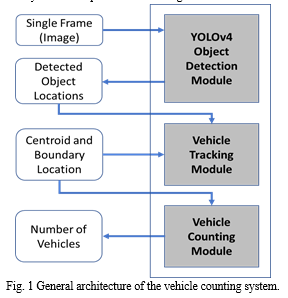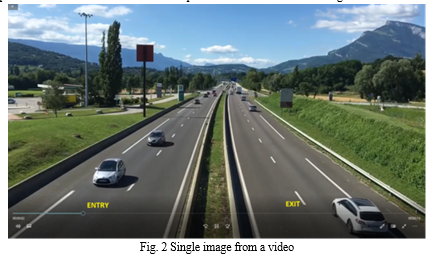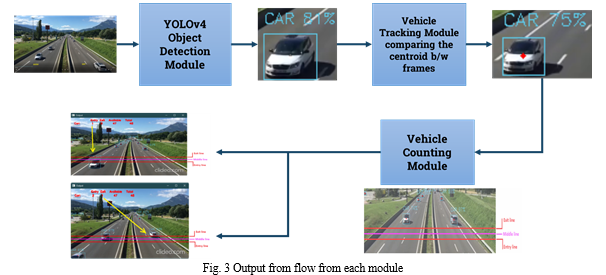Ijraset Journal For Research in Applied Science and Engineering Technology
- Home / Ijraset
- On This Page
- Abstract
- Introduction
- Conclusion
- References
- Copyright
Smart Parking Solution for Multi Building Campus
Authors: Rajanna K, Gaurav Karki, Dr. Shinu Abhi
DOI Link: https://doi.org/10.22214/ijraset.2022.46534
Certificate: View Certificate
Abstract
Locating parking space is becoming a serious problem as more and more employees prefer to switch to personal commute due to prevailing pandemic situation across globe in office campus. Particularly, where there is multiple building inside main campus, and it is quite challenging to keep track of car parking inside a given building. Without parking availability information, commuter must shuttle around builds to find parking space during peak hours, and this will be a loss of time as well as frustration to the commuter. There are few options companies follow like physically counting cars at certain interval and update the dashboard, install badge reader at entry and exit and people must punch card at both the places, sensors have been installed in certain parking lots, allowing management to track when cars enter and exit, install Radio Frequency Identification (RFID) and reader at entry and exit in order to track the capacity. All these methods will bring in burden on additional resource and high cost of installation of reader & necessary barricade systems respectively. Also, will add to regular maintenance of overall system. This project details DL implementation to create a vehicle counting system by using video from camera installed at the entry and exit path for vehicle. Pretrained model of YOLOv4 is used for object detection, vehicle tracking with Euclidean distance and counting. Since vehicle movement is considerably slow in pathway, performance of the model tested is 96.8% to 100% for varied frame rate of the video in parking capacity tracking.
Introduction
I. INTRODUCTION
It is challenging to keep track of available car parking space inside a given building. There are multiple buildings in main campus. Offices or buildings with separate entry and exit or single entry & exit. Post pandemic, employees prefer to use personal commute then public. Without parking availability information, employees must shuttle around builds to find parking space during peak hours, and this will be a loss of time as well as frustration experience to the commuter. In recent years, numerous proposals have been made for improved parking occupancy systems along with guidance. There are benefits and drawbacks to each of these modern systems. A method of determining whether or not a car is entering or exiting in a given space is essential to all of these systems. This mechanism could be anything from a straightforward ultrasonic sensor that detects a vehicle at a threshold distance to a sophisticated optical sensor that activates dependent on distance. The presence of a vehicle or other object is detected by these sensors. Much research has been conducted for traffic management applications based on image and video processing approaches. The analysis of traffic video data includes detection or recognition of vehicles, measurement of vehicle's speed, generation of tracking trajectory, counting of vehicles, congestion of traffic and collisions of vehicles. These applications have become popular recently due to the availability of low-cost cameras and embedded devices. Thus, the video data analytic is one of the prime research focuses in the computer vision and big-data area. This work proposes an easy-to-use system for counting vehicles based on the deep learning algorithm. A well-known pretrained YOLOv4 DL architecture known for its excellent accuracy in object detection and its moderate computation compared to other DL architectures. Vehicle tracking with Euclidean distance and counting entry and exit vehicles for accurate for parking capacity tracking.
II. LITERATURE REVIEW
The counting of vehicles is often performed by splitting the scene into a moving foreground and a stationary background. Background subtraction (BS) and blob analysis [1], BS combined with Gaussian Mixture Model (GMM) based BS [2] [3], and particle filter-based tracker [3], [4] are used to achieve this goal. Frame averaging, the Gaussian mixture model, and principal component images are common methods for achieving BS, However, when dealing with traffic data, the background removal method has its limits. Partial occlusion in processed picture data causes vehicles to merge, and inaccurate bounding box predictions are made. Additionally, car shadows lead to erroneous detection. The results are enhanced by combining a Gaussian mixture model and an expectation maximization to create the background model. The moving vehicles are then retrieved from the background using subtraction. Morphological features and colour histograms are used to deal with the occlusions.
One application of Computer Vison (CV) technology is in traffic monitoring systems, which can be used to keep tabs on things like vehicle speeds, parking lot occupancy rates, and traffic violations. The first step in every one of the aforementioned chores is finding where each car now resides. Therefore, an object detection method is so important. Pre-processing techniques like grayscale picture scaling, binarization of images, and background reduction [5] [6] or even edge detection are required by the traditional Machine Learning approach to accomplish this task. There are, of course, drawbacks to this method; for example, if the vehicle's shadow is present in the image, the detection may be less accurate. Changes to the road surface, such as road maintenance, road damage, or any barriers on the road, can also cause inaccurate detection since they can disrupt the image subtraction process. Although it is computationally expensive and requires a considerable amount of data to train the networks, the Deep Learning (DL) methodology provides more adaptable performance without the requirement to pre-process the image and extract the feature using multiple methods. There are even more advanced DL architectures available, which have been trained with millions of data points, making the creation of CV systems much simpler. It is well-known that the Convolutional Neural Networks (CNN) architecture of Deep Learning (DL) performs exceptionally well in Computer Vision (CV), particularly in the tasks of object detection and categorization. Regional-based CNN (R-CNN), Fast R-CNN, Faster R-CNN, Region-based Fully CNN (R-FCN), Single Shot Detector (SSD), Mask R-CNN, YOLO, YOLOv2, YOLOv3, and YOLOv4 are only some of the CNN-based architectures used in CV for object recognition and categorization. For this experiment, YOLOv4 was chosen as the best model to utilise because of its high accuracy and fast computation time in real time compared to the other object identification methods.
III. PROBLEM STATEMENT
Locating parking space is becoming a serious problem as more and more employees prefer to switch to personal commute due to prevailing pandemic situation across globe in office campus. Particularly, where there is multiple building main campus, and it is quite challenging to keep track of car parking inside a given building. Without parking availability information, employees must shuttle around builds to find parking space during peak hours, and this will be a loss of time as well as frustration to the commuter. There are few options companies follow like physically counting cars at certain interval and update the dashboard, install badge reader at entry and exit and people have to punch card at both the places, sensors have been installed in certain parking lots, allowing management to track when cars enter and exit., install Radio Frequency Identification (RFID) tag on each employee vehicle and reader at entry and exit in order to track the capacity. Very few or negligible companies have installed simple ultrasonic sensor at each parking space, and these are hardwired to the centralized system to detect parking occupancy. All these methods will bring in burden on additional resource and high cost of installation of reader & necessary barricade systems respectively. Also, will add to regular maintenance of overall system.
IV. OBJECTIVES OF THE STUDY
This project proposes to use advancement in deep learning robust method You Only Look Once (YOLO) which treats the object detection as a regression problem to map pixels into bounding boxes with class probabilities. Moreover, it computes everything in a single evaluation. Euclidean distance methodology for object tracking and boundary line to count entry or exit of the vehicle in a single frame of the video to capture the parking availability in each building. The primary objective of this study is to implement the customized smart parking solution for multibuilding campus offices. Having multibuilding it is extremely important to let the employees know where the parking space is available especially during peaking hour. A dashboard at each building entrance encompassing overall occupancy and available status will greatly help the employee peacefully approach the building where parking is available. Secondary objective of the study helps in selection of optimal video mode for better accuracy for model for vehicle detect and counting.
V. PROJECT METHODOLOGY
The vehicle counting system which was built in this work has three main modules, i.e., Object Detection Module, Vehicle Tracking Module and Counting Module as given in Figure No. 5.1. The first module reads every single frame from the video and doing vehicle detection using YOLOv4 algorithm. This module results the location of every detected vehicle, i.e., the bounding box coordinates. The second module tracks vehicle by its centroid location between frames to frame using Euclidean distance by checking centroid distance between frames is within threshold, to ensure same object is being tracked and the third module counts the number of vehicles that crossed the road depending on the coordinates or position of the vehicles. So, the result of object detection module plays vital function in this system, since if the vehicle is not spotted, then it will not be counted. Video containing entry and exit of the vehicle from singe camera is used to demonstrate the proposed solution.
A. Flowchart of Proposed Methodology
The workflow for vehicle detection at entry and exit is presented in the Fig. 1.

B. Dataset
Data for the proposed solution is implementation using video from surveillance camera having 81 second video with 1280 x 720 pixel having 30 frame per second frame rate and same video is converted to 15 frame per second frame rate for the study. This video has two-way traffic by which both entry and exit of vehicle data has been extracted to run through the model. In both the direction 48 cars will pass in enter and exit path each. Specifically, video of different frame rate was taken because more the frame rate means higher storage capacity of storage for surveillance. Hence most of the companies record the video at lower frame per second to reduce the storage space and the cost associated with it. Snap of the video is shown in the Fig. 2.

C. Experimental Setup
The proposed solution implemented using OPENCV 4.5.2 and PYTHON 3.8.5 in a machine with Intel(R) Core i5-10210U, CPU of 2.10GHz processor with 16GB RAM. Even though this engine is not as fast as the GPU enabled system, but sufficient to run the deep learning.
D. Module Processing Flow

VI. RESULT ANALYSIS
The vehicle counting system developed in this work is tested using two different videos as described in previous section. Since proposed solution used a pretrained YOLOv4, so there is no training phase in this work. In the first testing scenario, system using video with 1280 x 720 resolution, 30 frame per second and totally has about 2460 frames and in the second scenario, same video with 15 frame per second was used. Both the video has 48 cars passing in enter and exit path each. Differences between the actual number of vehicles and the number counted by the system are used to evaluate the system's efficiency. The resultant accuracy of the method is mentioned in the Table I
TABLE I
Accuracy result of the model
|
|
Entry |
Exit |
Entry Accuracy |
Exit Accuracy |
Overall Accuracy |
||
|
|
Actual |
Predicted |
Actual |
Predicted |
|||
|
Video with 30 fps |
48 |
48 |
48 |
48 |
100% |
100% |
100% |
|
Video with 15 fps |
48 |
48 |
48 |
45 |
100% |
93.8% |
96.9% |
|
|
|
|
|
|
Average Accuracy |
98.45% |
|
Conclusion
Smart parking solution which is developed by employing vehicle counting system at both entry and exit which process live or video feed has been developed using YOLOv4 for object detection, tracking by calculating Euclidean distance between centroid of a vehicle between frames and counting is simply executed by evaluating the distance between the vehicle’s centroid to the border line. It successfully achieved the highest accuracy of 100% when using 30fps video feed as discussed in chapter 9, then following Table below. The frame rate of the video affects performance since it symbolises the information integrity of the data that the system processes. Overall, this work was successfully finished with positive outcome and accuracy of the model is presented in Table I. A dashboard with the status of available car parking can be placed at main entrance of each building campus along with the parking status of rest of the other buildings within campus so that it helps employees proceed to the building where parking space is available without having to shuttle across building to find the space predominantly during peak hour. Selection of the frame rate can made based on the storage capacity or non-storage live feed can be used to for high accuracy and to avoid additional cost on storage. The proposed solution can further be extended counter other objects like motorcycle, bicycle..etc. With a higher-resolution camera, the same method can be applied to extract license plate information as well. Also, dashboard data can be made available to the employees over cloud or employee portal so that they can be well informed.
References
[1] T. H. Chen, Y. F. Lin, and T. Y. Chen, “Intelligent vehicle counting method based on blob analysis in traffic surveillance,” Second Int. Conf. Innov. Comput. Inf. Control. ICICIC 2007, pp. 1–4, 2007, doi: 10.1109/ICICIC.2007.362. [2] P. K. Bhaskar and S. P. Yong, “Image processing based vehicle detection and tracking method,” 2014 Int. Conf. Comput. Inf. Sci. ICCOINS 2014 - A Conf. World Eng. Sci. Technol. Congr. ESTCON 2014 - Proc., 2014, doi: 10.1109/ICCOINS.2014.6868357. [3] H. Jang, I. Won, and D. Jeong, “Automatic Vehicle Detection and Counting Algorithm,” Int. J. Comput. Sci. Netw. Secur., vol. 14, no. 9, pp. 99–102, 2014. [4] J. Quesada and P. Rodriguez, “Automatic vehicle counting method based on principal component pursuit background modeling,” Proc. - Int. Conf. Image Process. ICIP, vol. 2016-Augus, pp. 3822–3826, 2016, doi: 10.1109/ICIP.2016.7533075. [5] A. J. Kun and Z. Vámossy, “Traffic monitoring with computer vision,” SAMI 2009 - 7th Int. Symp. Appl. Mach. Intell. Informatics, Proc., pp. 131–134, 2009, doi: 10.1109/SAMI.2009.4956624. [6] Z. Iftikhar, P. Dissanayake, and P. Vial, “Computer vision based traffic monitoring system for multi-track freeways,” Lect. Notes Comput. Sci. (including Subser. Lect. Notes Artif. Intell. Lect. Notes Bioinformatics), vol. 8589 LNAI, pp. 339–349, 2014, doi: 10.1007/978-3-319-09339-0_35. [7] C. S. Asha and A. V. Narasimhadhan, “Vehicle Counting for Traffic Management System using YOLO and Correlation Filter,” 2018 IEEE Int. Conf. Electron. Comput. Commun. Technol. CONECCT 2018, no. March, 2018, doi: 10.1109/CONECCT.2018.8482380. [8] M. Fachrie and U. T. Yogyakarta, “Model,” no. June, 2020, doi: 10.13140/RG.2.2.15026.56001.
Copyright
Copyright © 2022 Rajanna K, Gaurav Karki, Dr. Shinu Abhi. This is an open access article distributed under the Creative Commons Attribution License, which permits unrestricted use, distribution, and reproduction in any medium, provided the original work is properly cited.

Download Paper
Paper Id : IJRASET46534
Publish Date : 2022-08-29
ISSN : 2321-9653
Publisher Name : IJRASET
DOI Link : Click Here
 Submit Paper Online
Submit Paper Online

